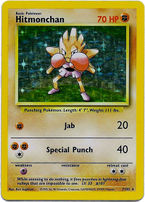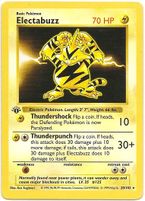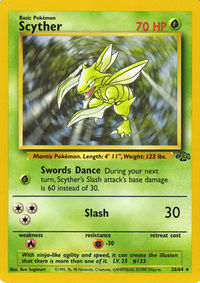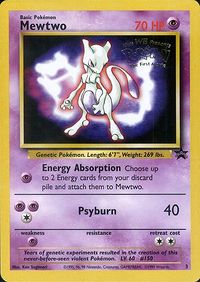Haymaker (TCG)
- Haymaker redirects here. For the skill in Pokémon Masters EX, see Haymaker (Skill).
| Haymaker | ||||||||||
|---|---|---|---|---|---|---|---|---|---|---|
| ||||||||||
The Haymaker deck archetype was a strong competitor in the early days of the Pokémon Trading Card Game. It was played heavily due to its fast, hard hitting nature that included control elements.
Strategy
As one of the earliest deck archetypes, Haymaker took advantage of useful Trainer cards and Basic Pokémon from Base Set and Jungle to set up quickly and strike hard quickly. The classic trio of Pokémon in Haymaker decks include Hitmonchan, Electabuzz, and Scyther. All are Basic Pokémon with 70HP, allowing them to be played straight from the hand and soak up damage early in the game. All have good damage to Energy cost ratios, with Hitmonchan able to deal 20 damage for ![]() , and Electabuzz able to deal 10 damage and potentially inflict Paralysis for
, and Electabuzz able to deal 10 damage and potentially inflict Paralysis for ![]() .
.
Trainer cards also factored heavily in Haymaker decks. Cards such as Bill, Professor Oak, and Computer Search allowed cards to be drawn and quickly populate the Bench. PlusPower gave extra power to attacks, while Energy Removal and Super Energy Removal could disrupt the opponent's strategy. Item Finder was also useful in recycling Trainer cards.
Key Cards
- Electabuzz - The ability to Paralyze with Thundershock on turn 1 allowed Electabuzz to set up for Thunderpunch on turn 2, with the possibility of dealing 40 damage. Important for hitting the Weakness of Blastoise.
- Hitmonchan - Hitmonchan could use its Jab attack on turn 1 for 20 damage. Its second attack, Special Punch, could deal 40 damage for three Energy. Important for hitting the Weakness of many Colorless and most Lightning Pokémon.
- Scyther - Primarily valued for its combination of 70 HP with Fighting Resistance and a free Retreat Cost. With the addition of Double Colorless Energy, Scyther could deal a consistent 30 damage from turn 2 with its Slash attack.
- PlusPower - Provides an additional 10 damage to a Pokémon's attack. Gust of Wind and matching Weakness, this allowed Electabuzz to quickly OHKO most Basic Pokémon.
- Energy Removal and Super Energy Removal - Allows the player to discard Energy from opposing Pokémon, limiting most opponent's to low Energy attacks. This was vital to Haymaker; even though 70 HP was large for a Basic Pokémon, multiple Evolved Pokémon could still OHKO this amount. Between S/ER and Gust of Wind, they never got the chance.
- Bill, Computer Search, Item Finder, and Professor Oak - Provides for the deck's draw and search needs, allowing the player to quickly setup. The usage of Bill was hotly debated, with the side in favor of it pointing out it made the deck faster and more consistent, while the side opposed preferred space for additional options and felt it both fast and consistent enough already. Item Finder was also often important late game, recycling a useful Trainer that had already been used several times or was discarded for other card effects.
- Gust of Wind - Controlling the opponent's Active could be used to stall for time, but it was mostly used to facilitate key KO's (preferably OHKO's) that would not only earn a Prize but weaken the opponent's own setup.
- Scoop Up - This card was used to deal with damage and the effects of attacks (including what we now call Special Conditions). Though you had to discard the Energy currently attached to the Pokémon in question, judicious use of single Energy attacks, �Scyther (with its free Retreat Cost), and/or Super Energy Removal could reduce or even eliminate this drawback.
Typical deck list
The deck list appearing below is not official; it is meant to represent an average build of the archetype, not specifically constructed for any regional metagame. Being that this is merely an archetype, a player may wish to change any part of this deck when building his or her own version.
| Quantity | Card | Type | Rarity |
|---|---|---|---|
| 4× | Electabuzz | ||
| 4× | Hitmonchan | ||
| 3× | Scyther | ||
| 3× | Computer Search | T | |
| 3× | Bill | T | |
| 4× | Energy Removal | T | |
| 3× | Energy Retrieval | T | |
| 3× | Gust of Wind | T | |
| 3× | Item Finder | T | |
| 4× | PlusPower | T | |
| 3× | Professor Oak | T | |
| 3× | Scoop Up | T | |
| 3× | Super Energy Removal | T | |
| 4× | Double Colorless Energy | ||
| 7× | Fighting Energy | — | |
| 6× | Lightning Energy | — | |
Possible tech cards
The following cards are often used in Haymaker in place of certain cards included in the above list.
- Mewtwo - A solid choice with 70HP and the ability to deal 40 damage for


 . So long as there is Energy in the discard pile, its Energy Absorption attack allows Mewtwo to set up quickly allowing players to choose up to 2 Energy cards from there.
. So long as there is Energy in the discard pile, its Energy Absorption attack allows Mewtwo to set up quickly allowing players to choose up to 2 Energy cards from there. - Magmar - Good for stalling the opponent with its Smokescreen attack and 70HP, while its stronger attack, Smog, provides the opportunity to Poison the opposing Pokémon.
- Energy Search - This card would further thin the deck while snagging the exact basic Energy card needed. Some preferred to use the space for Rainbow Energy or additional copies of the desired basic Energy.
- Lass - In a deck where any Trainer cards will be used up relatively quickly, Lass can be used to disrupt the opponent's strategy with little to no impact on the players'.
- Switch - This card was sometimes used as an alternative to running more copies of Scoop Up or Double Colorless Energy. Used well, it could help conserve Energy.
- Nightly Garbage Run - Can be used to shuffle in energies and Pokémon from the discard pile to your deck which is useful when playing against decks such as Chansey/Alakazam stall. This card can put back the energies and Pokémon discarded by Item Finder and Computer Search.
- Muk - Muk is used for its ability Toxic Gas which is used for blocking useful abilities, such as Rain Dance on Blastoise.
Restriction
The Haymaker deck, being comprised mostly of cards made in the first few sets of the TCG, was one of the first to be essentially, but not explicitly, banned from play as the cards were taken out of Pokémon Organized Play. Due to its loss, however, the TCG was allowed to grow, and new strategies were eventually able to take root.
Hitmonchan, Electabuzz, and Scyther were all reprinted as Retro cards in the Platinum expansion, allowing them to be played in the Modified format during the latter part of the 2008-2009 season, and throughout the 2009-2010 season.

|
This article is part of Project TCG, a Bulbapedia project that aims to report on every aspect of the Pokémon Trading Card Game. |



